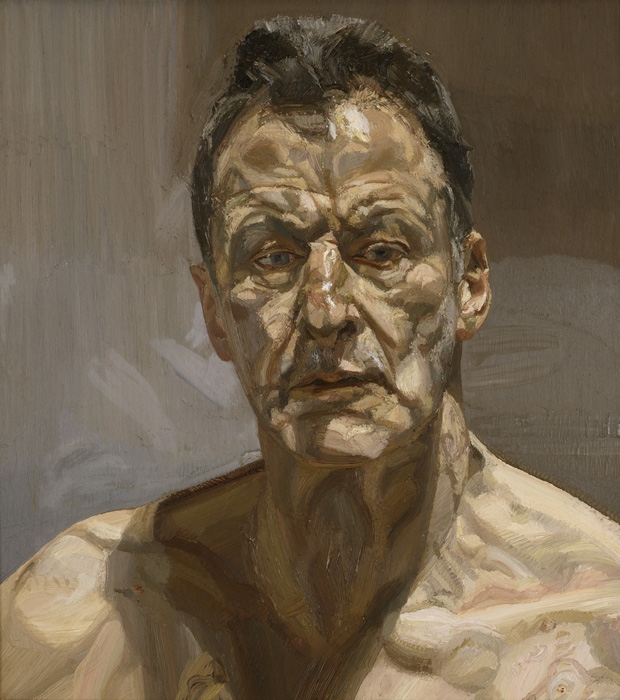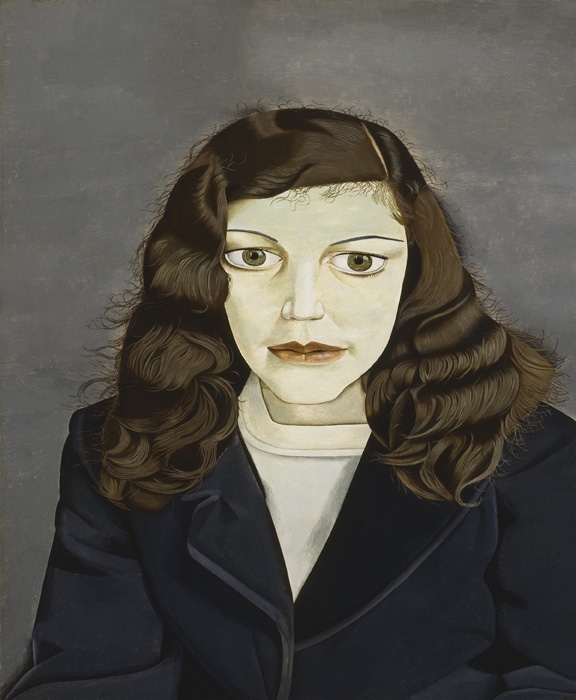Lucian Freud: Portraits, National Portrait Gallery | reviews, news & interviews
Lucian Freud: Portraits, National Portrait Gallery
Lucian Freud: Portraits, National Portrait Gallery
A moving and deeply impressive exhibition of an artist with a singular vision
Sitting for Lucian Freud was quite a commitment. Unlike Hockney, whom he painted and who painted him, Freud was a very slow painter and he was methodical. Paying close attention to detail and absorbed by different textures, he was intent on building up surfaces meticulously, layer upon layer. This meant that sessions would usually go on for several months, sometimes years.
For Freud (pictured below right: Reflection [Self-Portrait], 1985) verisimilitude was paramount – naturally he was a truth-seeker. But you can say that's the case with most portrait artists. What marked Freud out – or at least just one of the things that marked him out – was his strangeness, and this belies any straightforward description of him as a realist painter.

We begin not at the beginning, but with a series of etchings from the Eighties and Nineties which you can see just at the entrance to the exhibition. In these mostly close-up portrait heads in compressed spaces we find Lord Goodman in His Yellow Pyjamas. His head viewed from below, it’s clearly a likeness that’s designed to suggest a striking resemblance to an imperious walrus. Humans are just a species of animal, Freud had often remarked, and although none of the early portraits are nudes, we see this most evidently when the human animal is unclothed.
Similarly arresting is the slant-eyed, satirical coolness of the early paintings. These have more than a passing resemblance to the younger Scottish artist John Bellany and his odd, slyly sinister fishing folk. The earliest painting here is a roughly textured work featuring Freud’s art tutor Cecil Morris, painted when Freud was just 18 in 1940. But we are soon confronted by the meticulously smooth-surfaced portraits of his first wife Kitty Garman. In Girl with a Kitten and Girl in a Dark Jacket (pictured below), both painted in 1947, Kitty’s huge, moist eyes – as well as the Egyptian-looking cat’s (the creature appears as if on the point of strangulation) – are as big as sailing boats. She looks as if she’s lost in a deep trance, whilst the paintings themselves possess a fiercely hypnotic intensity.

Looser, coarser brushwork characterises Freud’s later paintings, and in some, such as Smiling Woman, 1958-59, the mottled flesh looks almost at the point of dissolution. The gaze, too, has softened, the eyes downcast, life concentrated inwards. The tense brittleness has given way to a raw, unguarded intimacy. And textures are more carefully rendered – the chintz of a battered sofa, the weave of a rattan chair, the worn, shiny leather of a pair of pink pumps whose bulging contours follow the shape of the foot.
Some of his best-known paintings are here: the beguiling theatrical group portrait of Large Interior, W11 (after Watteau), 1981-83 (main picture); the severely angled Reflection with Two Children (Self-Portrait), 1965, in which Freud resembles a suave Sixties East End gangster; and the fleshy, mountainous landscape of Sue in Benefits Supervisor Sleeping, 1995. (Sue features again in one of the more bizarre paintings in this exhibition, Evening in the Studio, 1993, in which her awkwardly lolling figure is made to resemble a weird Hans Bellmer doll.)
And Freud’s very last painting is here, too. Portrait of the Hound, 2011, is a large scale painting of his assistant David Dawson and Eli, Dawson’s whippet, and it remains unfinished. Freud worked on it for four years until he was too frail to continue. One can't help but be moved by it. And one can't help but be deeply impressed by the singular vision that leads us here.
- Lucian Freud: Portraits at the National Portrait Gallery until 27 May
rating
Share this article
The future of Arts Journalism
You can stop theartsdesk.com closing!
We urgently need financing to survive. Our fundraising drive has thus far raised £49,000 but we need to reach £100,000 or we will be forced to close. Please contribute here: https://gofund.me/c3f6033d
And if you can forward this information to anyone who might assist, we’d be grateful.

Subscribe to theartsdesk.com
Thank you for continuing to read our work on theartsdesk.com. For unlimited access to every article in its entirety, including our archive of more than 15,000 pieces, we're asking for £5 per month or £40 per year. We feel it's a very good deal, and hope you do too.
To take a subscription now simply click here.
And if you're looking for that extra gift for a friend or family member, why not treat them to a theartsdesk.com gift subscription?
more Visual arts
 'We are bowled over!' Thank you for your messages of love and support
Much-appreciated words of commendation from readers and the cultural community
'We are bowled over!' Thank you for your messages of love and support
Much-appreciated words of commendation from readers and the cultural community
 Lee Miller, Tate Britain review - an extraordinary career that remains an enigma
Fashion photographer, artist or war reporter; will the real Lee Miller please step forward?
Lee Miller, Tate Britain review - an extraordinary career that remains an enigma
Fashion photographer, artist or war reporter; will the real Lee Miller please step forward?
 Kerry James Marshall: The Histories, Royal Academy review - a triumphant celebration of blackness
Room after room of glorious paintings
Kerry James Marshall: The Histories, Royal Academy review - a triumphant celebration of blackness
Room after room of glorious paintings
 Folkestone Triennial 2025 - landscape, seascape, art lovers' escape
Locally rooted festival brings home many but not all global concerns
Folkestone Triennial 2025 - landscape, seascape, art lovers' escape
Locally rooted festival brings home many but not all global concerns
 Sir Brian Clarke (1953-2025) - a personal tribute
Remembering an artist with a gift for the transcendent
Sir Brian Clarke (1953-2025) - a personal tribute
Remembering an artist with a gift for the transcendent
 Emily Kam Kngwarray, Tate Modern review - glimpses of another world
Pictures that are an affirmation of belonging
Emily Kam Kngwarray, Tate Modern review - glimpses of another world
Pictures that are an affirmation of belonging
 Kiefer / Van Gogh, Royal Academy review - a pairing of opposites
Small scale intensity meets large scale melodrama
Kiefer / Van Gogh, Royal Academy review - a pairing of opposites
Small scale intensity meets large scale melodrama
 Jenny Saville: The Anatomy of Painting, National Portrait Gallery review - a protégé losing her way
A brilliant painter in search of a worthwhile subject
Jenny Saville: The Anatomy of Painting, National Portrait Gallery review - a protégé losing her way
A brilliant painter in search of a worthwhile subject
 Abstract Erotic, Courtauld Gallery review - sculpture that is sensuous, funny and subversive
Testing the boundaries of good taste, and winning
Abstract Erotic, Courtauld Gallery review - sculpture that is sensuous, funny and subversive
Testing the boundaries of good taste, and winning
 Edward Burra, Tate Britain review - watercolour made mainstream
Social satire with a nasty bite
Edward Burra, Tate Britain review - watercolour made mainstream
Social satire with a nasty bite
 Ithell Colquhoun, Tate Britain review - revelations of a weird and wonderful world
Emanations from the unconscious
Ithell Colquhoun, Tate Britain review - revelations of a weird and wonderful world
Emanations from the unconscious
 Rachel Jones: Gated Canyons, Dulwich Picture Gallery review - teeth with a real bite
Mouths have never looked so good
Rachel Jones: Gated Canyons, Dulwich Picture Gallery review - teeth with a real bite
Mouths have never looked so good

Add comment